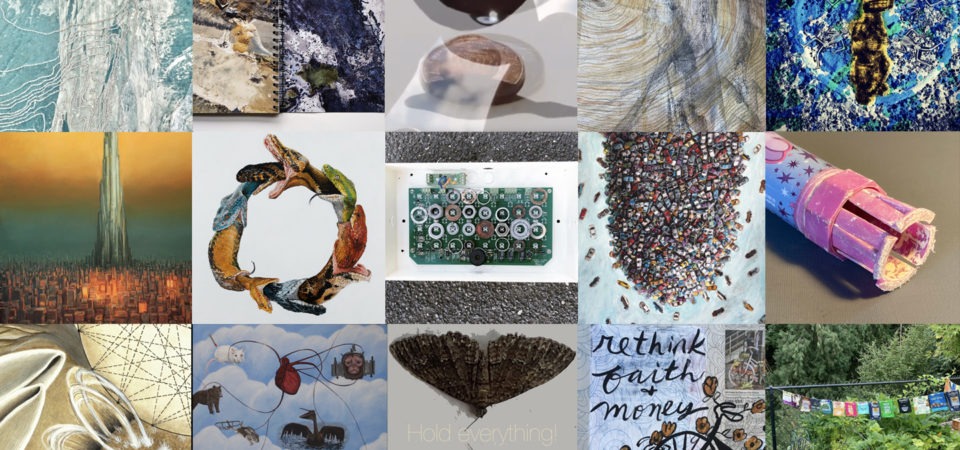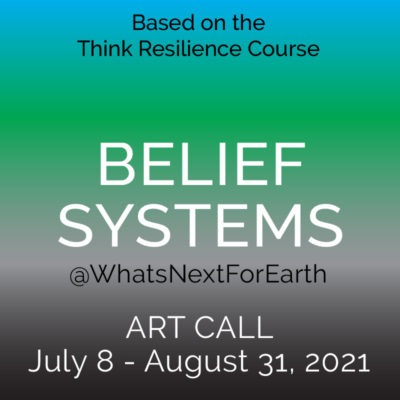
“Seen in historical and anthropological perspective, the belief in progress and growth was a superstructure suited to a particular kind of infrastructure. As our energy sources—and hence our infrastructure—change throughout the remainder of this century, the most fundamental assumptions that gave meaning to life during the fossil fuel era may cease to do so. We may then need a new superstructure to guide us—a new set of universally shared beliefs based in shared experience. If our future is tied to renewable sources of energy, if climate change is shaping the world around us, and if amounts of energy available to us are limited, it is possible that our new beliefs will once again be ones that place humanity within, rather than outside of, nature. Instead of seeing our destiny in the stars, we may once again come to see our role as serving nature rather than mastering it. More than that, it may be too soon to say.”
Richard Heinberg, Think Resilience course.
The Belief Systems art call is based on Think Resilience, the Post Carbon Institute’s free online course. To respond to the art call, we asked the artists to signup and to watch the course, one lesson at a time:
Lesson 1: Introduction
Chapter One – Our Converging Crisis
– Lesson 2: Energy
– Lesson 3: Population and Consumption
– Lesson 4: Depletion (Resources depletion)
– Lesson5: Pollution
Chapter two – The Roots and Results of Our Crises
We explore the role of human behavior in our sustainability crises, and dig deeper into where those crises are taking us:
– Lesson 6- Political & Economic Management (Social Structure)
– Lesson 7- Belief Systems
Each video is approximately 12 minutes long.
Think Resilience is hosted by Richard Heinberg, one of the world’s leading experts on the urgency and challenges of moving society away from fossil fuels.
We live in a time of tremendous political, environmental, and economic upheaval. What should we do? Think Resilience is an online course offered by Post Carbon Institute to help you get started on doing something. It features twenty-two video lectures—about four hours total—by Richard Heinberg, one of the world’s foremost experts on the urgency and challenges of transitioning society away from fossil fuels. Think Resilience is rooted in Post Carbon Institute’s years of work in energy literacy and community resilience. It packs a lot of information into four hours, and by the end of the course you’ll have a good start on two important skills:
1. How to make sense of the complex challenges society now faces. What are the underlying, systemic forces at play? What brought us to this place? Acting without this understanding is like putting a bandage on a life-threatening injury.
2. How to build community resilience. While we must also act in our individual lives and as national and global citizens, building the resilience of our communities is an essential response to the 21st century’s multiple sustainability crises.
Featured Artists:
Kirsten Aaboe, Claude Benzrihem, Marianne Bickett, Marie Cameron, Christina Conklin, Eliza Evans, Michele Guieu, Petra Jelinek, Pascal Ken, Rosemary Hall, Terri Hughes-Oelrich, Deborah Kennedy, Michael Kerbow, Nancy D Lane, Suzette Marie Martin, Quin De La Mer, Livia Milani, Cristian Pietrapiana, Sailev, Marcela Villasenor, Michelle Waters.
Rosemary Hall
Instagram @rosemaryhhall
River of Shadows
Video Clip
2021
River of Shadows meditates on surface tension as a means to explore water and extractive growth-based economies as the driving force of climate change. (Created for a Third Coast Disrupted: Artists + Scientists on Climate in Chicago in 2021
This video was made specifically thinking about flooding and flood-prone infrastructure in the Chicago area. I now live in a region suffering the opposite water issue, one of continued “exceptional drought”. My home is a block away from the Ventura River, which reflects craggy oaks and Turkey vulture cyclones and now has mostly evaporated. This lack of water is most strikingly illustrated by the lake Casitas reservoir, who supplies drinking and agriculture water to the area. Image three shows the rings along the shore where the water annually recedes. I feel the water and lack of it every day.
As I reflect on water and belief systems I think of the myth of Narcissus. Narcissus dies gazing at his reflection in a pool of water. After his death a narcissus flower sprouts in his place. The myth is a cautionary tale of self-obsession especially pertinent in an age of individualism. But maybe it could be read as the opposite, if you were to sit and reflect on yourself in the water perhaps you would“remember you are water” -Adrienne Marree Brown, emergent strategy.
Caring for the waters is a process of healing ourselves and aligning belief systems again towards one that does not separate humans from nature but sees the interconnection with all systems.
How do you fall in love with your waterness? How can we care, live and die in a way that supports the flourishing of life? With areas witnessing deluge and others drought, how do we create and support systems that are resilient, where the bubble never completely bursts and is also never completely empty?Ha
Sailev (Honfleur, France)
Instagram: @sailev_art
The New Ouroboros
Oil on linen
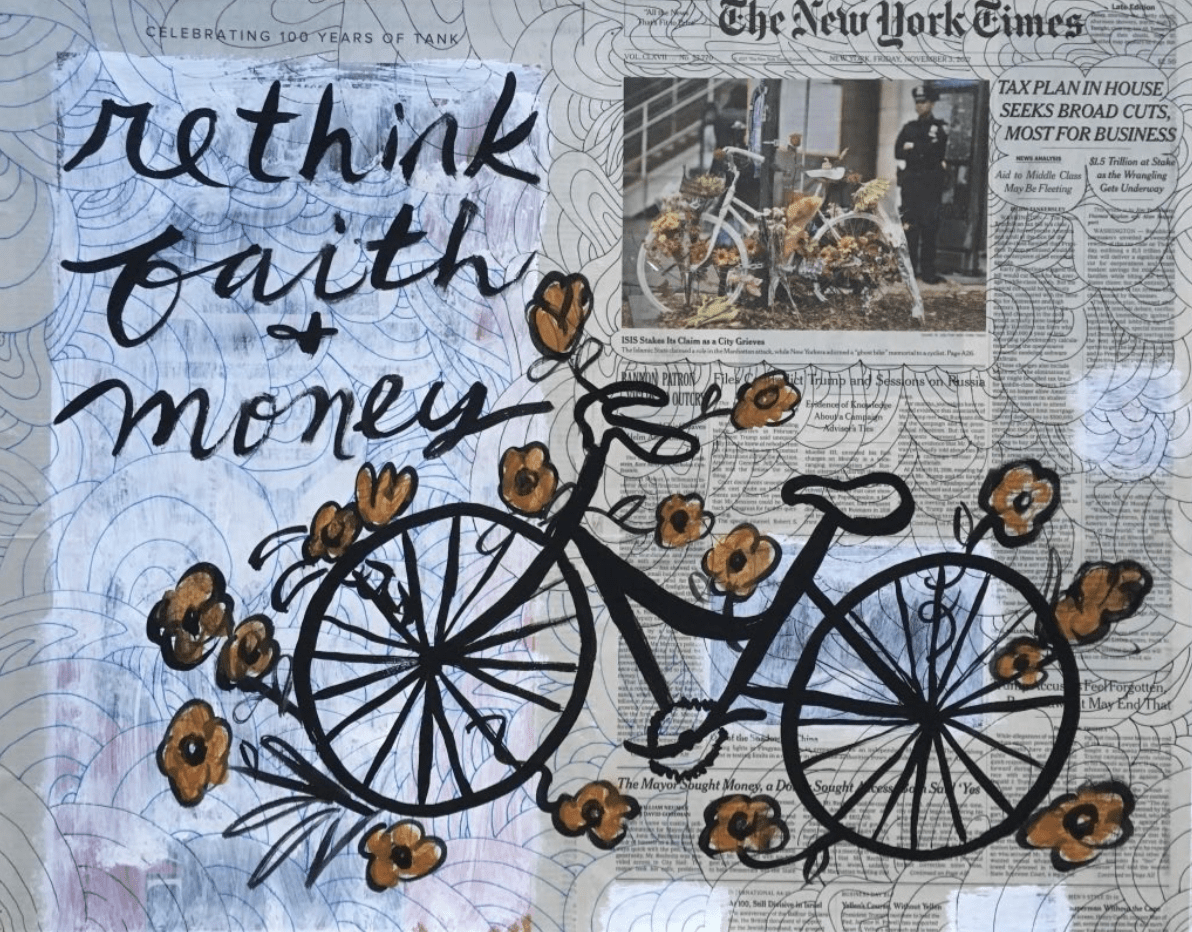
Cristian Pietrapiana (NYC, US)
Instagram: @cristianpietrapiana
‘To put everything in balance is good, to put everything in harmony is better.’
Victor Hugo.
ink, acrylic on paper.
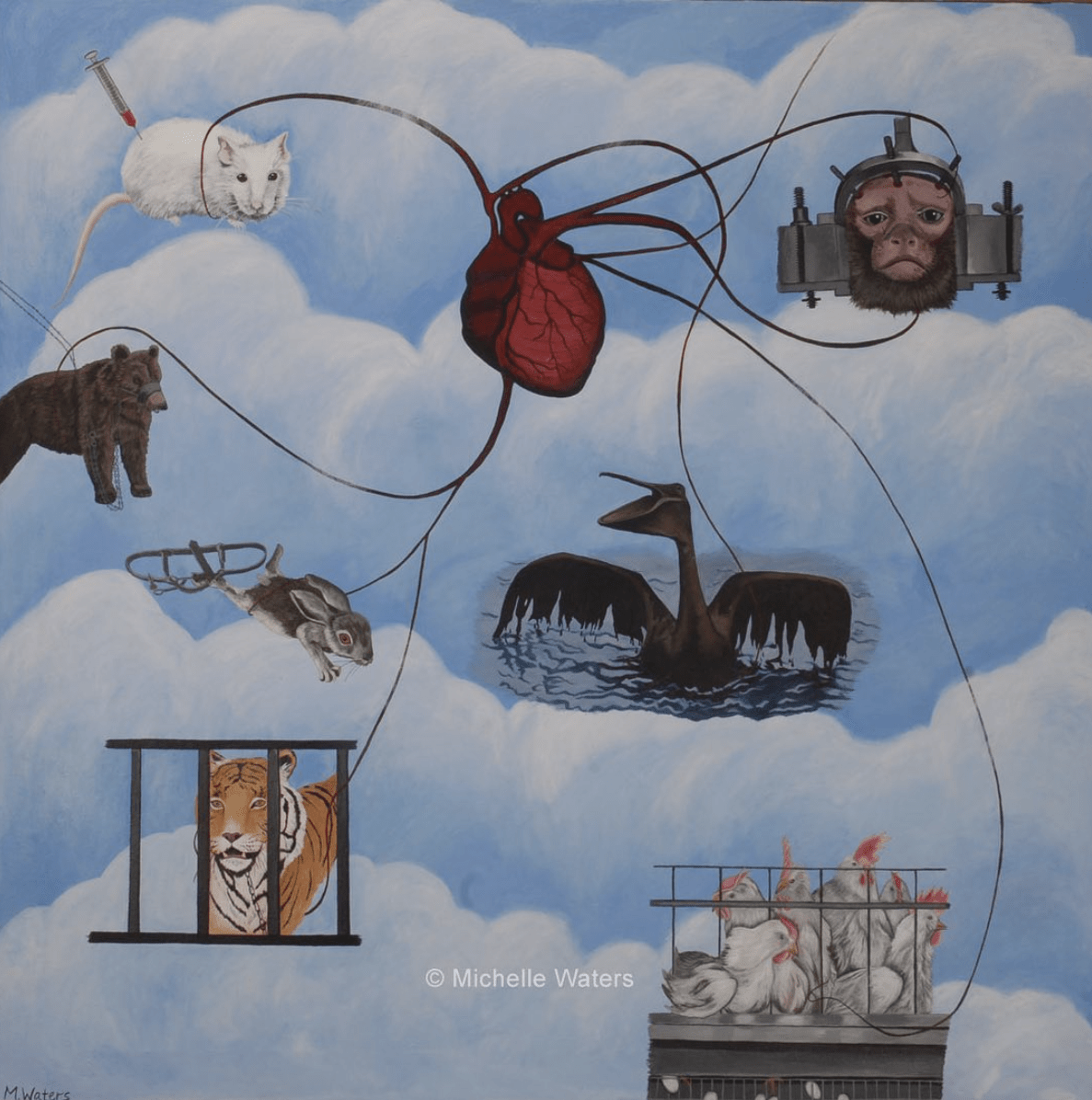
Michele Waters (San Francisco Bay Area, California, US)
Instagram: @michellewatersart
This piece is called “The Activist’s Heart”, and I painted it a few years ago as a tribute to all the amazing animal activists who work to change the world for animals. I don’t know that there’s ever been a study on this, but from my experience most vegans and animal activists I know are empaths, and feeling deeply for the emotional and physical suffering of animals combined with the indifference of most people is really hard on us. I decided to post this because I’ve been really overwhelmed lately – even more than I usually am – with the reality of the extinction crisis. From animals dying en masse in wildfires and floods as a result of the climate catastrophe, to government agencies killing wild animals for cattle ranchers, to the billions of animals killed every year in slaughterhouses and laboratories, it all has been feeling unbearable. I think those who have been active for decades trying to save the planet and her creatures are now collectively thinking “we told you so”, as we’ve been ignored and mocked instead of listened to.
The root cause of both climate emergency and extinction crises is speciesism and the idea that humans are the most important species on Earth and can and should control nature. This hubris is now proving to be our undoing. And unless we change the paradigm of believing we have the right to use nature and animals however we want to, no technological fixes will get us out of the crisis we are now in.
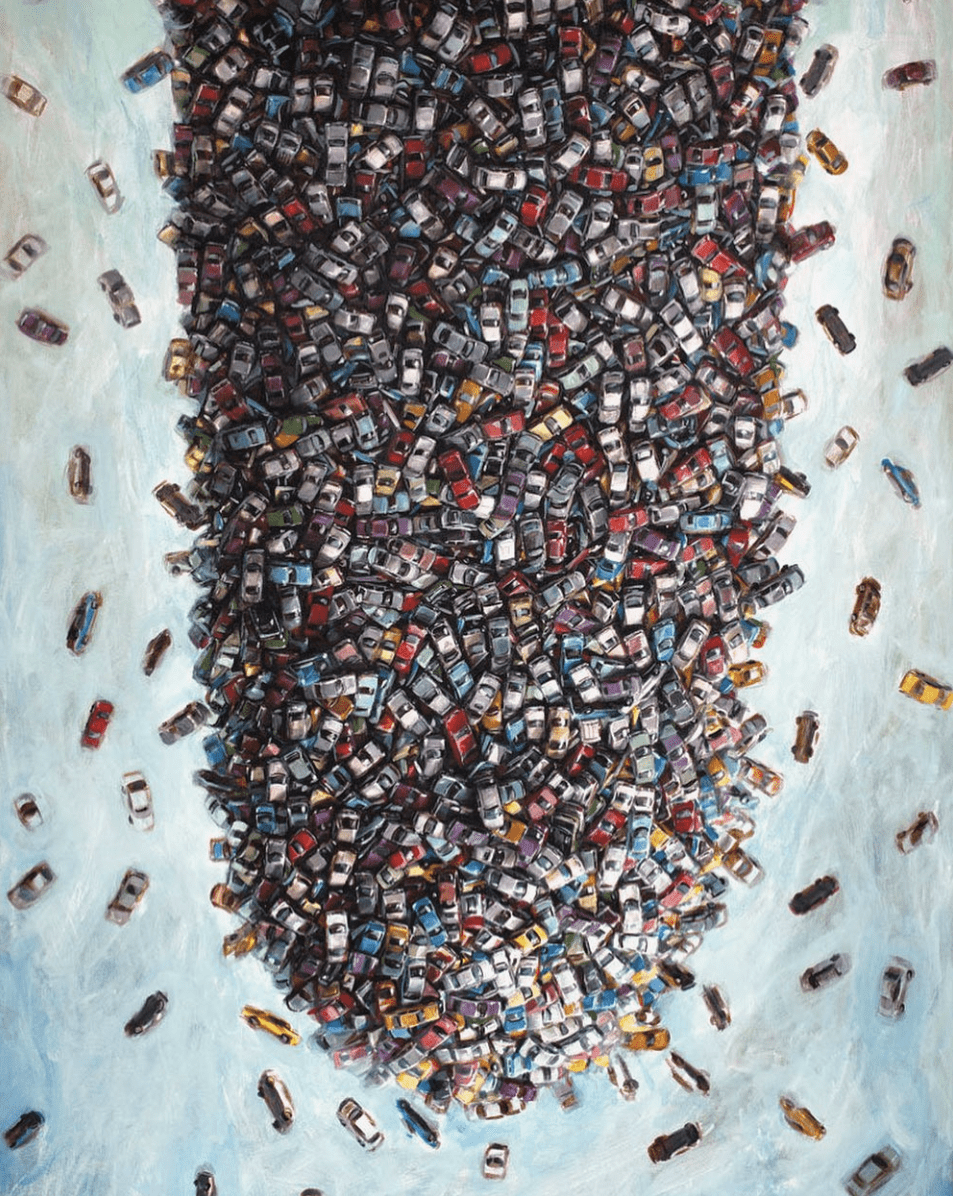
Michael Kerbow (San Francisco, California)
Instagram: @michaelkerbow
Here’s a throwback Thursday from 2010. My painting “Hive”, which was an early work from my Aberrations series. This image was when cars first began to make an appearance in my work. At the time I thought of this as an apt metaphor for our industrialized society. From the perspective of an outside observer, our existence probably seems surreal. Basically, we are a species that travels around in metal machines that slowly pollute and cook our world. It seems so illogical. Hopefully, this will soon be an obsolete perspective as we transition from fossil fuels to a more sustainable form of existence.
Michael Kerbow (San Francisco, California)
Instagram: @michaelkerbow
I created this painting about a decade ago. It’s from my Portents series which are a series of allegorical works intended to be visions of our imminent future. This painting depicts a towering structure where the world’s powerful elite reside. This 1% of society live in luxury, high in the sky, lording over everyone else crowded below. Of course, this is already happening today. Just look at the many luxury buildings in all the major cities around the world. I suppose it is ironic that my painting now hangs in a penthouse loft of such a place. But artists need to eat too, so I appreciate the patronage.
Nancy D Lane (Melbourne, Australia)
Instagram: @nancydeesculptures
Circuit Interrupted 2
Left: Photomontage of 9 close-ups of work
Right: Assemblage sculpture comprising found circuit board, nuts and washers, 19x31x7cm
This work addresses the dominant belief system in today’s society that humanity will prosper only through continuous economic growth. We need a change in mindset — a circuit breaker.
The many different nuts and washers affixed to the circuit board suggest that each of us, in our own way, can interrupt this non-stop cycle of production and consumption. We are capable of developing ways of living that are more thoughtful and creative, and less resource-intensive, to avoid climate catastrophe.
Marie Cameron ( San Fransisco Bay Area, California, US)
Instagram @mariecameronstudio
El Capitan
Found photograph, silk thread
7” x 5”
2021
I believe we need to look at the big picture. To see the interconnection of all things. Science helps us to see this but so does our heart, we will need both more than ever going forward. In this piece, I embroidered a topographical map over a vintage photograph of El Capitan from 1965. I think it speaks to the beauty of understanding our environment and our relationship to it from multiple perspectives.
Deborah Kennedy (California, US)
Instagram @deborahkennedyart
A poem, essay, and illustration from my book Nature Speaks: Art and Poetry for the Earth. Web of Life: Seeing the Connections
Dr. W. D. Billings, a life sciences professor at Duke University, authored Plants, Man, and the Ecosystem, an important book that influenced the field of botany. His text explored a new, holistic model of a functioning botanical environment. Prior to his research, botanists usually worked in a reductionist manner. The natural world is so complex, botanical researchers often altered just one element, such as water or sunlight, to understand the impact on growing plants. Dr. Billings analyzed living botanical environments using a systems theory perspective and modeled the complex, inter-dependent relationships needed to foster life. Subsequently, he created an intricate line drawing that modeled his concept. This poem is a celebration of Dr. Billings’s new, systemic understanding of living ecosystems.
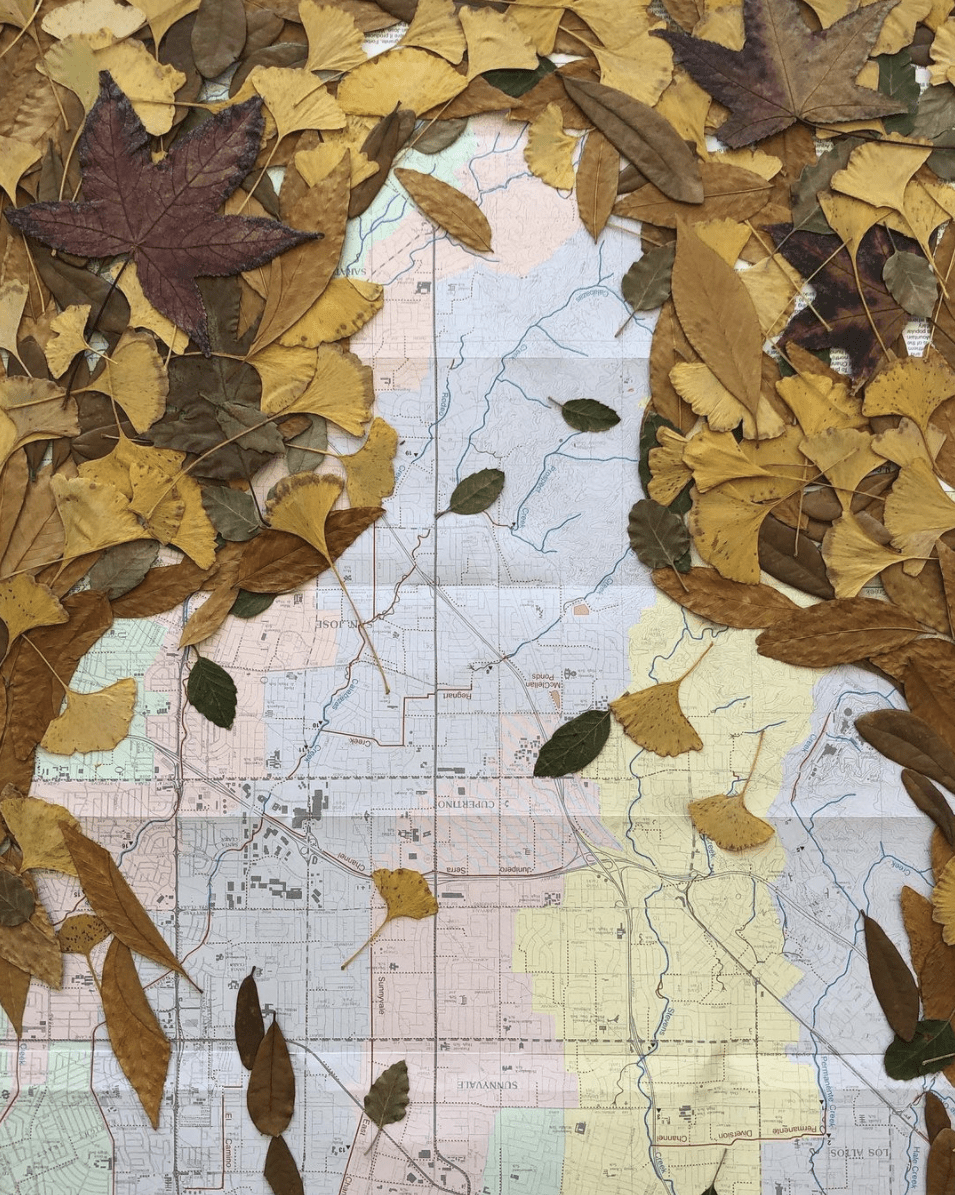
Michele Guieu (Sunnyvale, California, US)
Instagram: @micheleguieu
To a Regenerative Future
Ephemeral composition
Leaves from my neighborhood, map
2021
Economic growth is proportional to the destruction of nature. We extract non-renewable resources and use the renewable ones at an unsustainable rate. We transform them, distribute them, discard them, and create exponential pollution due to the burning of fossil fuel. This infernal cycle is destroying the likelihood of a livable planet for most of the living species, including ours, in a very near future.
Transitioning to new energy is an absolute necessity, but the destruction will continue if we do not change our belief systems. The deep belief in infinite growth and progress associated with it, enabled by large amounts of cheap fossil fuels, is very recent in human history.
The future will look different, and not just because we are going to see more windmills. As we are about to transition to a world where sobriety must be part of the new story, it is our entire relationship to nature that we need to change in order to survive.
“Instead of seeing our destiny in the stars, we may once again come to see our role as serving nature rather than mastering it.”
Richard Heinberg, Think Resilience Course, Post Carbon Institute
Suzette Marie Martin (Massachusetts, US)
Instagram: @szttmrtn
Dryad of the King’s Pines
Painting
Colonialism, ecological collapse, mythology, and grief. This new painting features a life-size 400-year-old tree stump, tiny molecular notation for greenhouse gasses, and a tree spirit mourning forests decimated by clear-cutting in colonial times and climate change in present times.
“Dryad of the King’s Pines” is based on a true colonial story of natural resource extraction for political and economic dominance. In the 1750s, King George I of England claimed exclusive rights to the largest of the ancient, enormous Eastern white pines (Pinus Strobus) in the New England colonies, marking them for harvest to build ships for the Royal British Navy. “The Pine tree Riots” of 1772, a rebellion by settlers who also wanted access to the trees, was a precursor to the American Revolution.
The classical education of upper-class Europeans who sponsored the colonization of the “New World” embraced Ancient Greek mythology, a pantheist belief system with female deities acting as spiritual embodiments of living elements of nature, as well as ecosystems.
I use my anachronistic “dryads of the Anthropocene” as a proxy to embody ecological grief over human destruction of the forest ecosystems these deities symbolically nurtured, protected, and blessed.
Fewer than 1% of old-growth forests remain in North America, decimated by logging that continues into the 21st century. Pinus Strobus commonly reaches 200 years of age at maturity but has been recorded at over 450 years old.
Quin de la Mer (Indian Wells, California, US)
Instagram @i3rstudios
Earth Won Now Earth
White Sands Missile Range, New Mexico, US
video
Belief systems change when our infrastructure changes. Not because we choose it willingly, it is in response to global shifts that require us to change the methods we use to survive as a species. We’ve seen the patriarchy through to its end. Earth responded to our war upon them. We live the consequences. Earth won. It’s time for us to replace sky god, king, and patriarchy with peace, love, and loyalty to Earth.
I LOVE YOU EARTH ❤️
From my point of view, we do it cold turkey … or … accept ourselves as intentional participants in collective self-murder and mass extinction of species. There’s no middle ground.
Livia Milani (Milan, Italy)
Instagram: @liviaaisling
In collaboration with:
Archive sites, books, journal Instagram: @archivebkj
Lilja.db Instagram @lilja.db
Sara Marcon Instagram @esseremarcon
Circuito – Scars of the land: Minerals, Conflicts, E-wastes.
Magazine mockup, 30×21 cm, in collaboration with
@lilja.db
@esseremarcon
The production of electronic devices nowadays requires natural materials such as minerals and metals and continues scarring territories, causing political, social, economic and health crisis. To understand the circuit that connects Earth’s exploitation to digital age, we have to start with the places where these materials come from.
Visual arts represent a new way of thinking and deconstructing crystallized narratives in order to create new forms of interconnection, dialogue and collaboration between the Global South and the Global North.
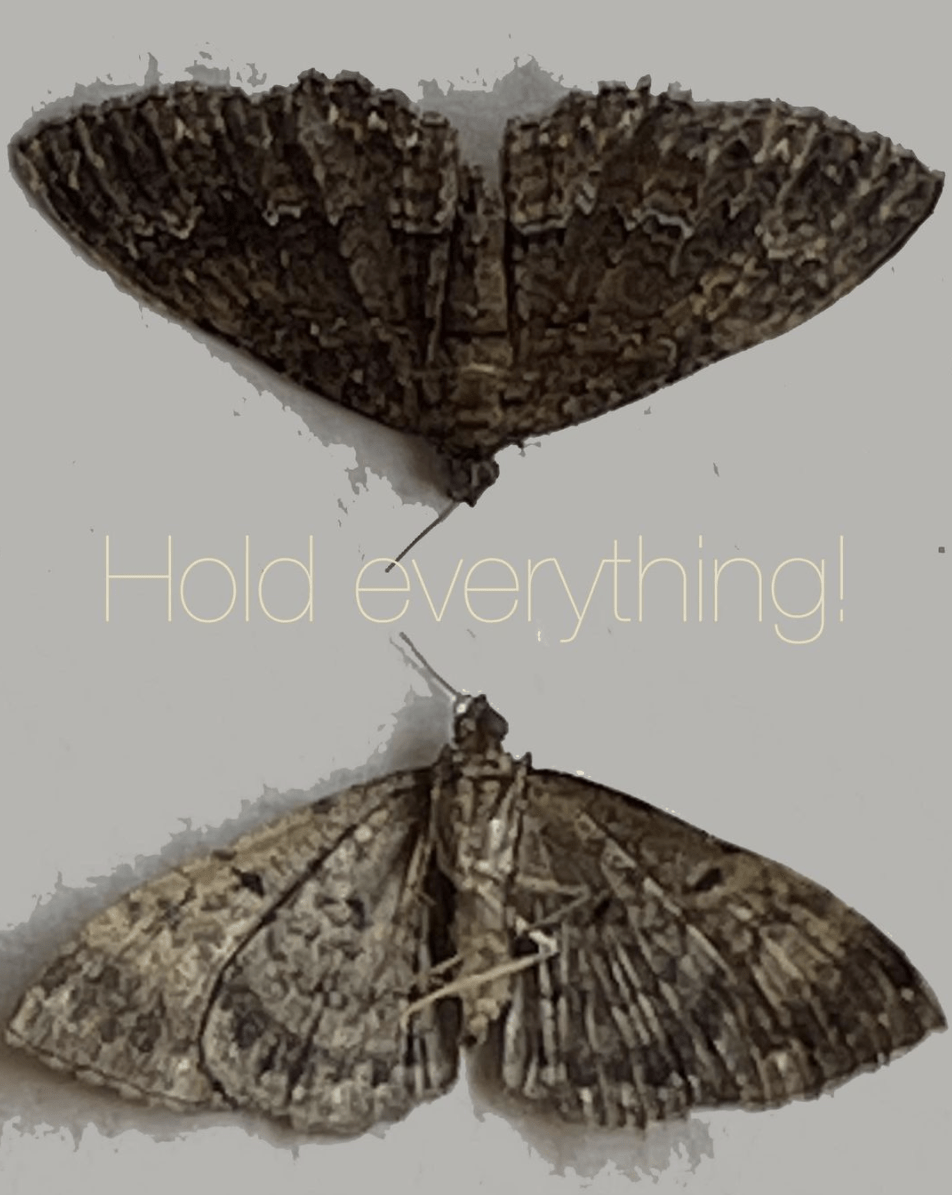
Kirsten Aaboe (Twentynine Palms, CA, US)
Instagram: @_aaboe_
Hold Everything
Multimedia digital photo collage
The headlong pursuit I’ve been stuck in, of acquiring, using, and then discarding, in an endless cycle, reinforces my mono-directional thinking and assumptions based on individual rights to the exclusion of how my actions fit into the whole systems we’re all part of. If I ratchet back my actions, take hard looks at my ‘needs’ and ‘desires,’ I find there is exquisite beauty all around me.
Hold Everything is a portrait of a very small moth I found on my studio floor. Cherishing means I won’t destroy as much.
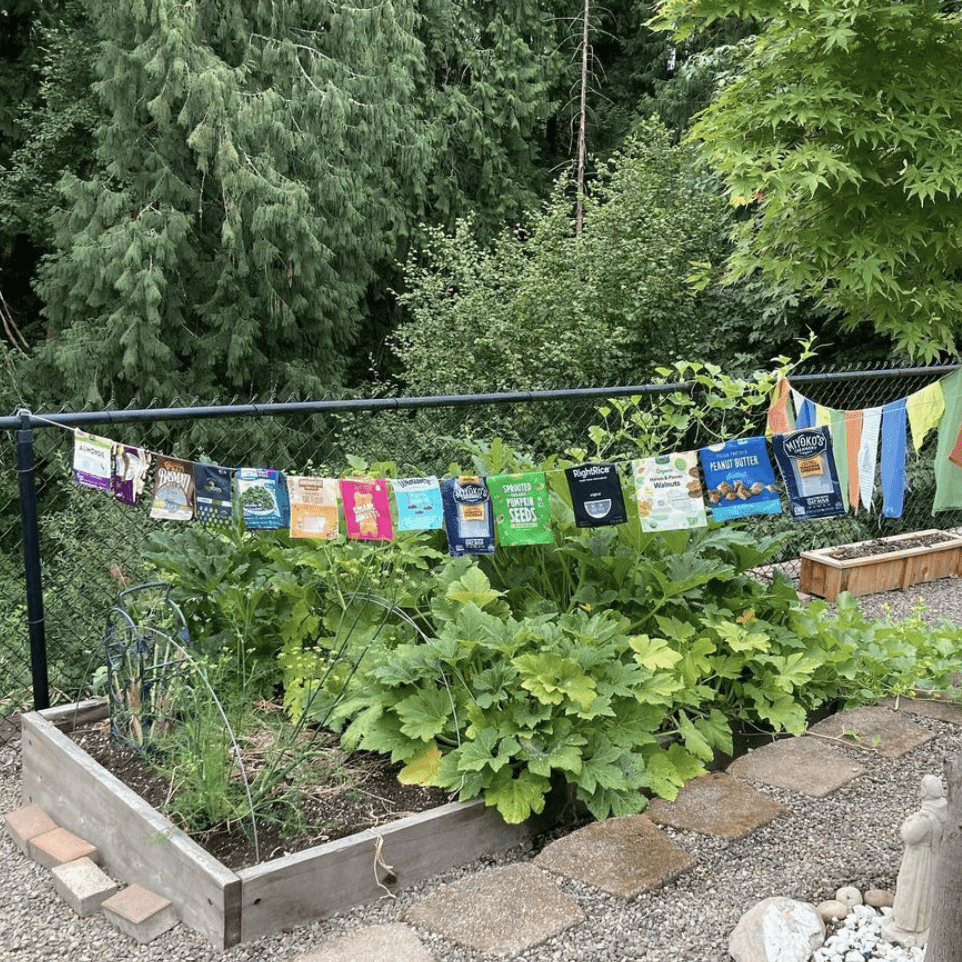
Marianne Bickett (Oregon, US)
Instagram: @mariannebickett
Manufacturers can endlessly toss the burden of non-sustainable, non-recyclable packaging to consumers so the problem goes away…that it’s not their problem!
I strung together colorful plastic packaging near our cloth Tibetan prayer flags as prayer flags asking manufacturers to take responsibility for their packaging. All the food these bags contained were organic and sustainably sourced. These are supposedly good companies that seem to care about the environment. But they pass on their non-recyclable packages to us, consumers. Please call, email, write the companies whose products you buy in such packages, and plead with them to consider alternatives like silicon, paper, and any other compostable bags. The solution is a huge challenge but we have brilliant minds who I know can develop a better way! When we put our minds to it, we can do anything that is important to us!! Think about it! We made it to the moon and we contemplate Mars…
I know we can choose to not buy these products. We’ve cut way back after this sobering year where I have stored every single non-recyclable bag and product we’ve purchased. It has made a huge impact on our choices. But sometimes I have no choice due to diet issues where I can only eat certain foods, and the pandemic has kept me away from bulk options.
Anyway, I could go on and on but it’s food for thought!
We reuse and repurpose these bags so that helps, too.
Thank you!
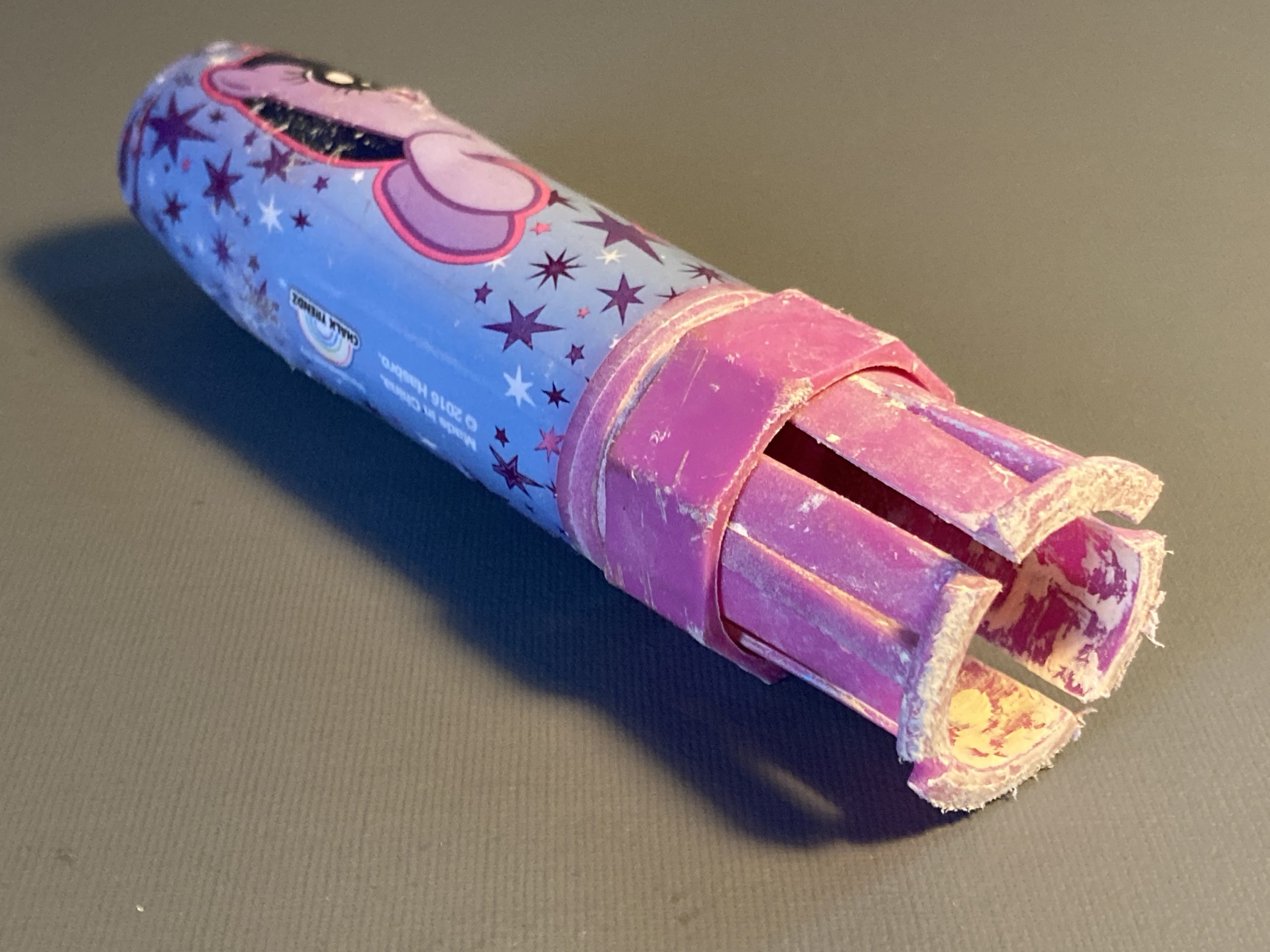
Terri Hughes-Oelrich (California, US)
Instagram: @hughesoelrich
Don’t get your fingers dirty!
digital photo
One day I found this on the street near my house. It took me some time to figure out what its use is. One end was open and the colors told me it was a children’s toys. It’s not a beautiful piece of trash, but I added it to my plastic collection. When I figured out that it holds chalk to probably draw on the streets, it made me sad. Not only can kids not get chalk on their fingers, but someone actually spent their time creating this chalk holder and design the ugly pattern. After studying plastic more closely last year, many lids and caps have extra plastic for aesthetics reasons. Beauty and function have long interested me, and this adds to the reasons we love plastic so much and hate it.
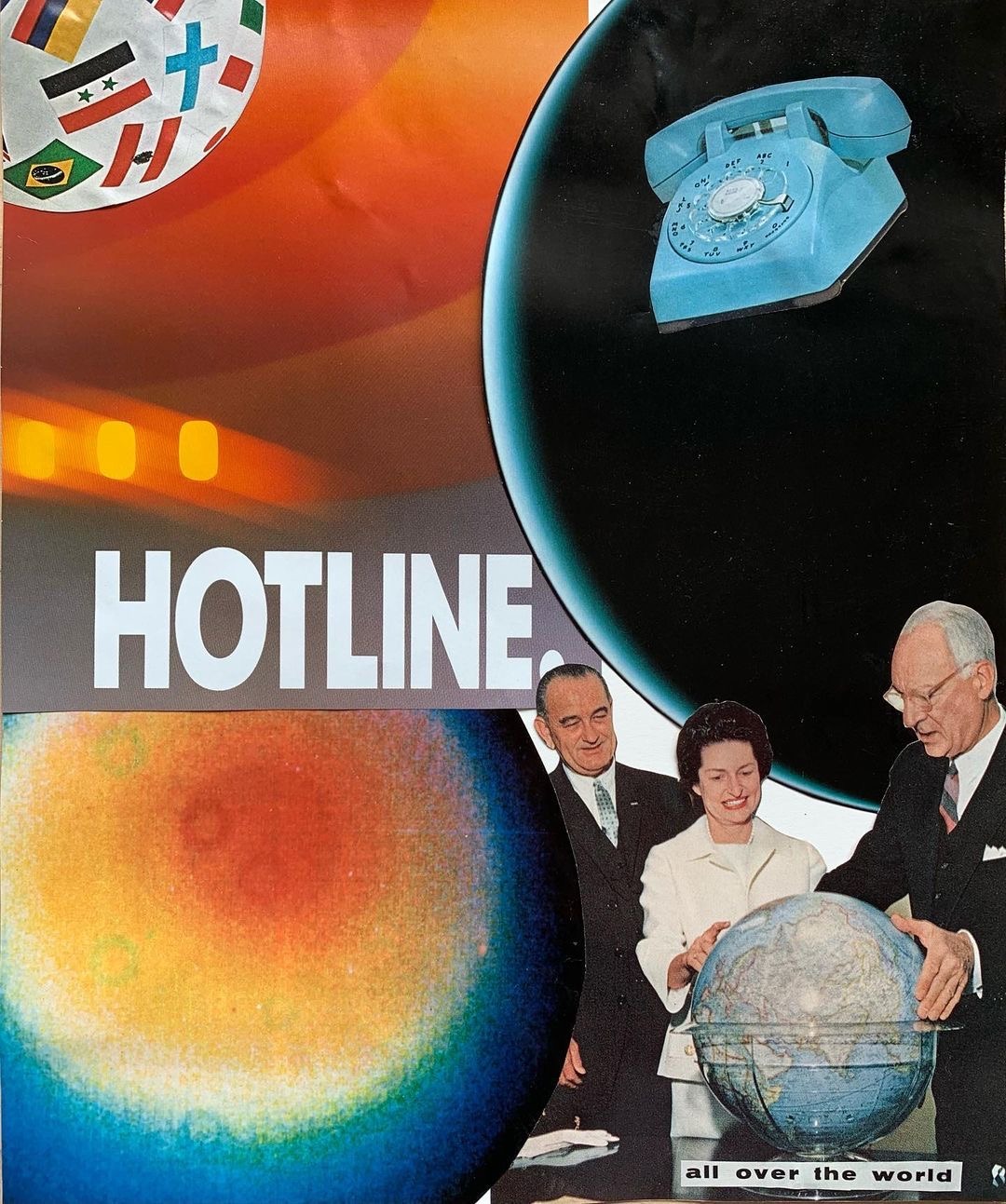
Christina Conklin (California, US)
Instagram bychristinaconklin
Each work in this series of Collapse Collages is created from one old National Geographic, in an attempt to understand where we are now by looking at how we understood ourselves then. The dissonance can be loud.
Though I grew up in a liberal-minded home in the 70s and 80s, and my mom in particular was of a “waste not, want not” Midwestern heritage, there was not much awareness growing up about where our “belongings” or privilege came from or at whose expense. We were charitable and concerned about suffering locally and around the world, but it felt distant. I even grew up in the Unitarian Universalist Church, which affirms “the interdependent web of existence, of which we are a part” — but I never learned about systems thinking in school or felt any movement in the culture at large toward depth, meaning, or connection. Instead, Reaganomics grabbed us all by the throat and became the dominant belief system of my lifetime.
This legacy of human and white supremacy, going back 500+ years, is the foundation of modern belief systems, and it has brought us to the brink of global collapse. Telling new stories is our only war through this mess.
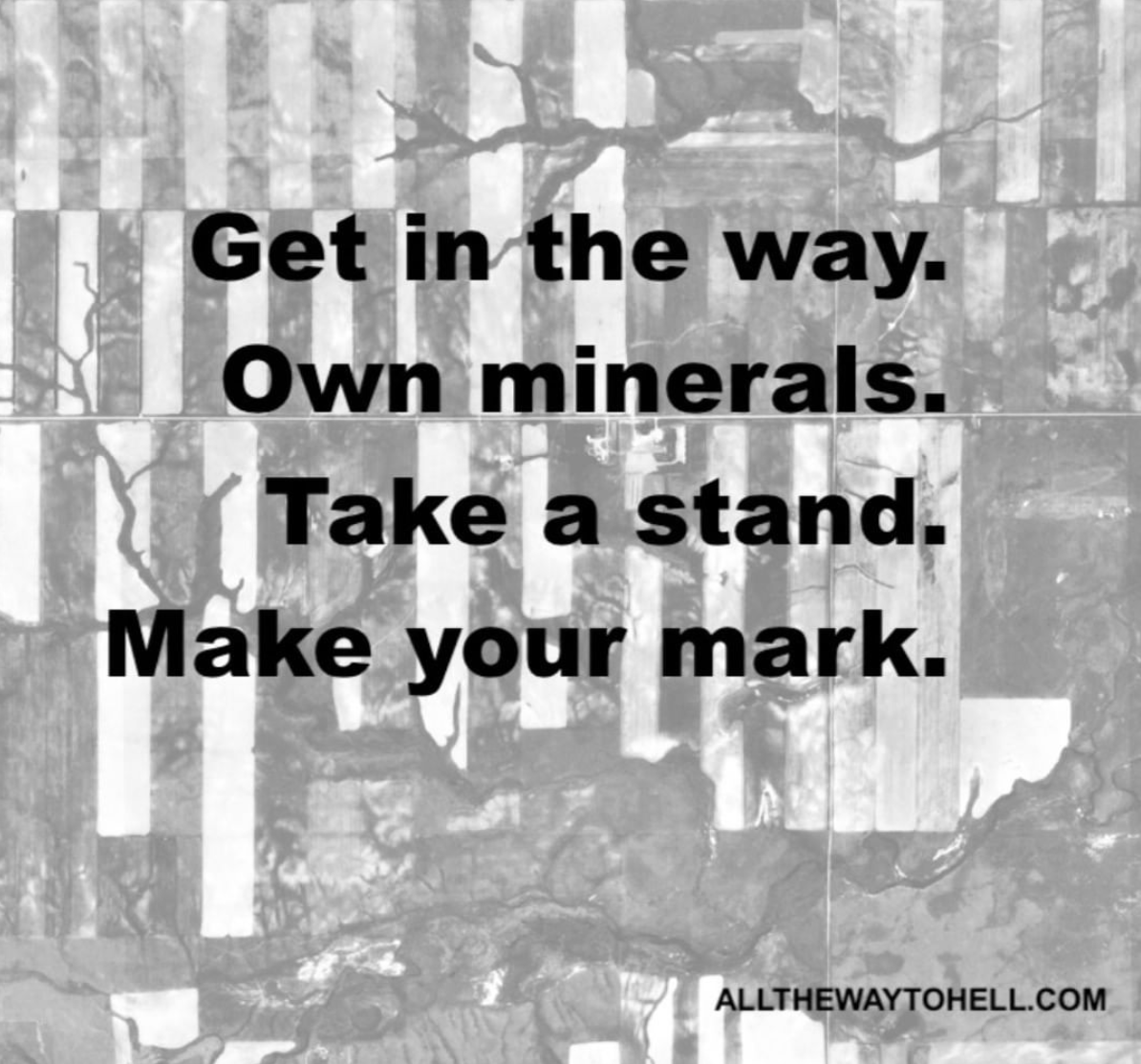
Eliza Evans
Project: All The Way To Hell
Instagram @all.thewayto.hell
All the Way to Hell is a conceptual art project, a platform for multigenerational and geographically distributed protest, and an experiment in energy democracy through distributive justice.
All the Way to Hell is giving away mineral rights to the Oklahoma property to as many people as possible. This fragmentation makes re-aggregating mineral properties into something drillable tedious, expensive, and time-consuming for prospective frackers.
All the Way to Hell redefines the value of mineral rights ownership in terms of safeguarding a just, desirable future compatible with human and more than human thriving rather than an asset that can be exploited in furtherance of petro-capitalism. The mineral rights as art objects can be collected, shared, and passed down.
Each mineral right, which entitles the owner to substances below the surface, measures approximately 12 feet long, 11 feet wide, and 4,000 miles deep as mineral rights in the U.S. extend, in theory, to the center of the earth. Each participant is engaging in the largest collaborative land-art project ever conceived.
All the Way to Hell is a platform for a 100-year sit-in. The participant spends no money and assumes minimal risk but commits to have their name on a deed to benefit others who may be geographically and generationally distant. Mineral rights are not age-restricted. The youngest participant is four years old, and minors can participate of their own accord. There are currently more than 350 project participants.
This project acknowledges the violent and forcible divestment of the land from Indigenous and Black people by white settlers and specifically acknowledges the enduring rights Muscogee Nation citizens and Black Oklahomans.
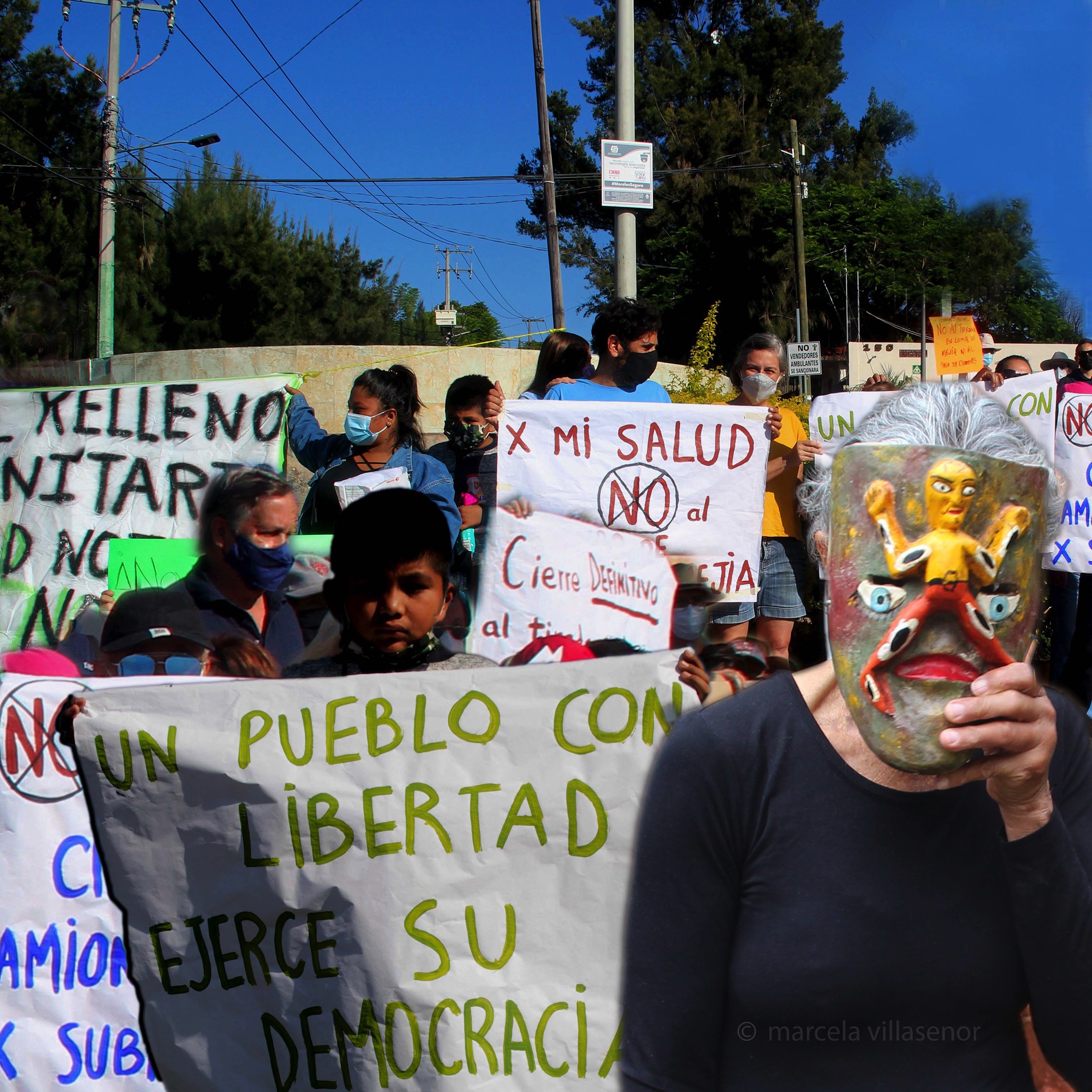
Marcela Villaseñor (California, US)
Instagram: @mvillasenor
Cuernavaca México “Protesta 6/21”
2021
“Un pueblo con libertad ejerce su democracia”
“A people with freedom exercises their democracy”
Protesta para el cierre definitivo del “Relleno Sanitario” Loma de Mejía, actualmente conocido como tiradero de Loma de Mejía, ubicada en las faldas de la reserva ecológica del Noroeste de Morelos.
En esta zona se ubican mantos acuíferos vitales para el sur del estado de Morelos, una extensa biodiversidad y zonas residenciales.”
Protest for the definitive closure of the Loma de Mejia “Sanitary Landfill”, currently known as de “Loma de Mejia Dump” located on the slopes of the Northwest Morelos ecological reserve, in this area there are vital aquifers for the south of the state of Morelos, an extensive biodiversity and residencial areas.”
LINK here.
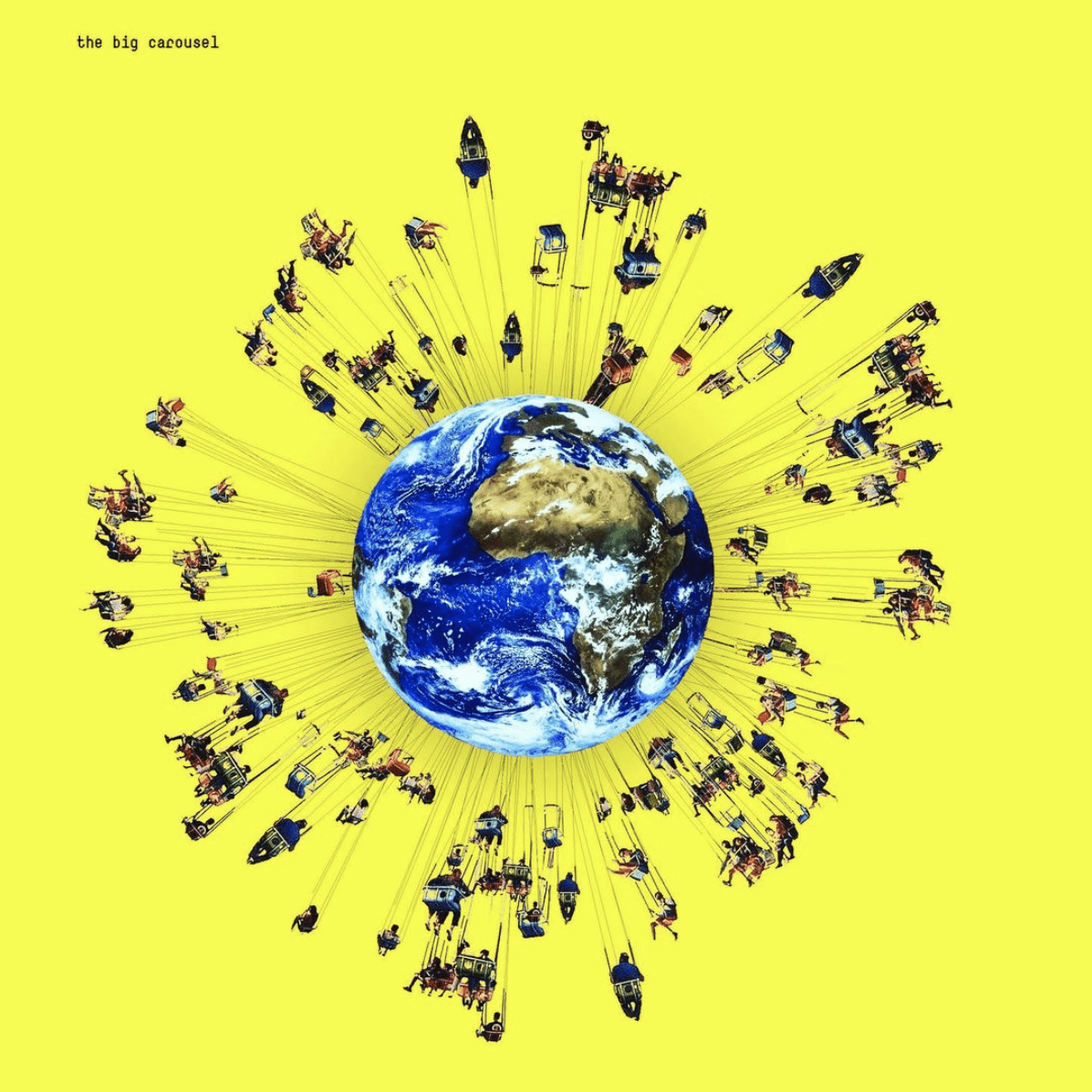
Claude Benzrihem (Paris, France)
Instagram @cbdesign.paris
Et pourtant elle tourne…
And yet it’s moving…
Digital stamp – numeric collage
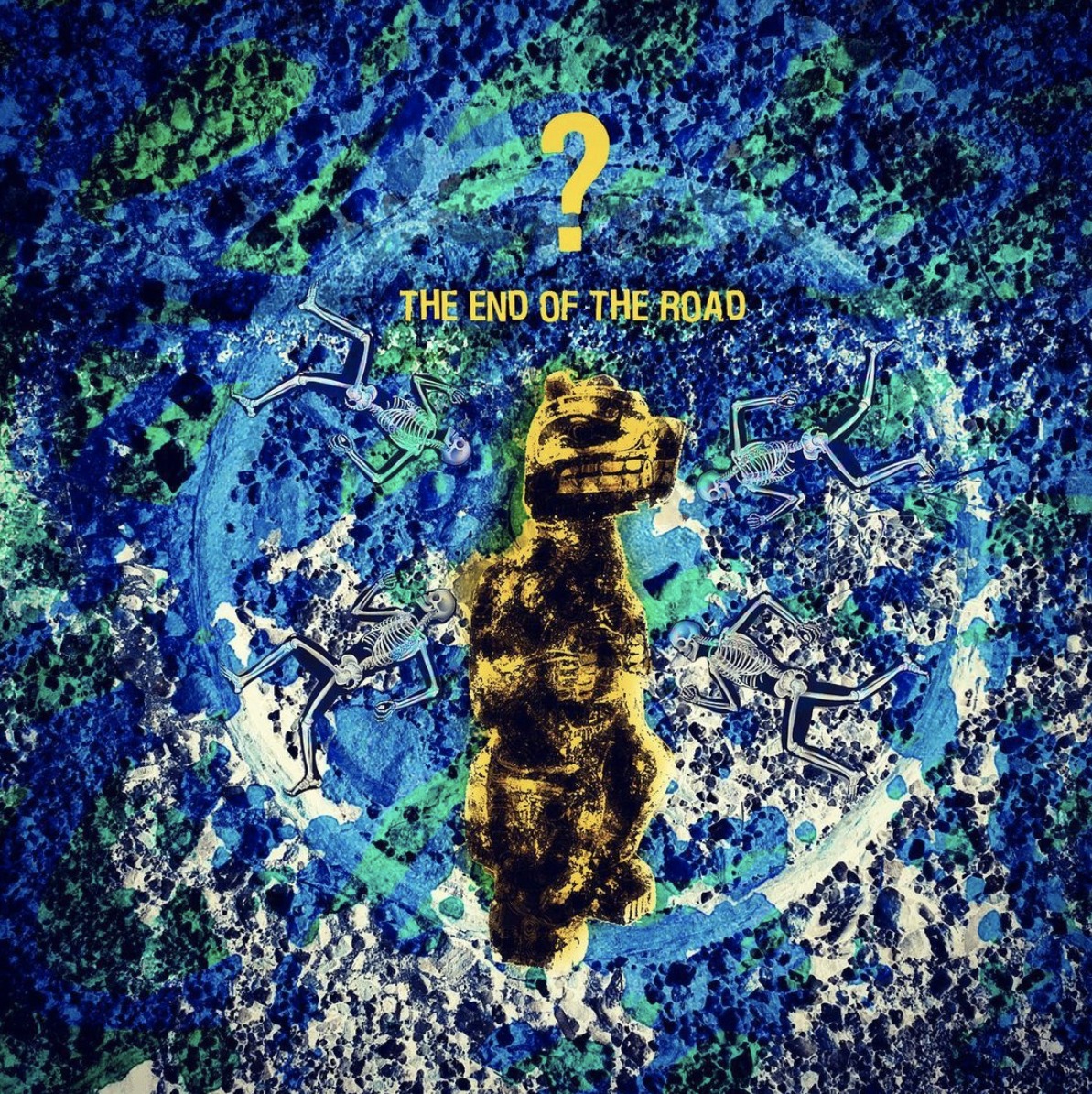
Pascal Ken (Saint-Brévin-Les-Pins, France)
Instagram: @pascalken
The end of the road?
20x20cm photography digital collage
Acrylic drawing
When our economic system is gonna collapse? A long time ago, we have been told that only one economic system could run on and on! How can we still believe this? Everywhere around the world, new experiences, new ideas, new systems, the germinated seeds are like rays of hope of a new world 🌎
Petra Jelinek (Illinois, US)
Instagram: @pet_jelinek
Thornton Quarry
2020
Structures we build to mine the earth’s natural resources are affected by the same forces of weathering and erosion that impact the environment itself. These human-made landscapes are part of our global ecosystems, shift, and change over time.
Petra Jelinek (Illinois, US)
Instagram: @pet_jelinek
This 90 year old feed mill, showing the wear and tear of weathering and erosion on its beautiful, utilitarian form. Slated to be torn down sometime in the next year.
What’s Next For Earth is an art project created by Michele Guieu, eco-artist, and MAHB Arts Coordinator, to reflect on the climate emergency, the human predicament and envision a desirable future. The project is supported by the MAHB. If you have any questions, please send a message to michele@mahbonline.org.
Thank you ~

